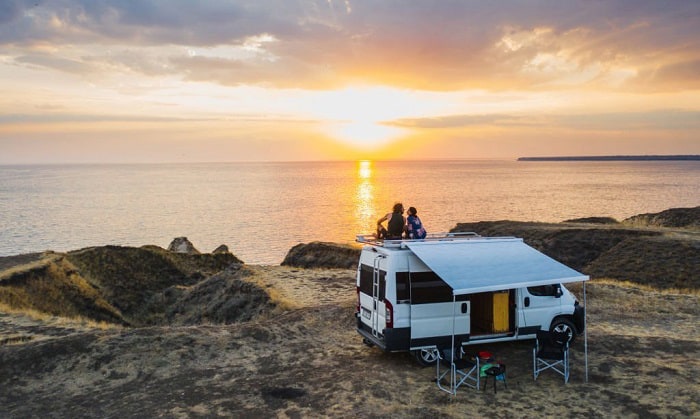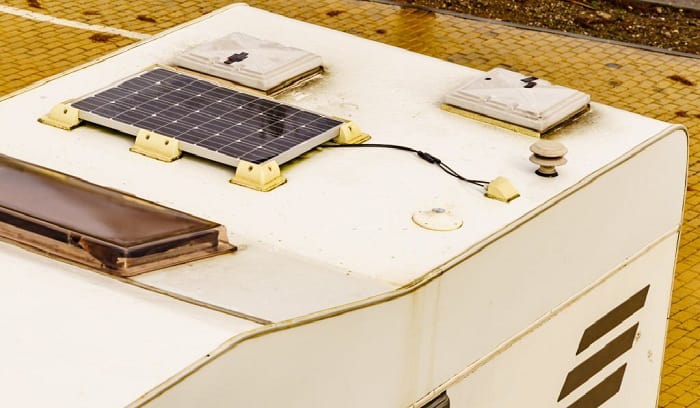If you have a Forest River RV, or any brand really, you have a choice between TPO and EPDM roofing. These materials must be able to withstand damaging weather elements such as harsh rain, heat from the sun, and even high winds.
We have developed this guide to help you understand the features of these two products. Both are extremely durable and resistant to sunlight. However, there are a few distinct differences to keep in mind when comparing EPDM vs TPO roofing for RV.
Page Contents
Definition of TPO vs EPDM Roof
1. What is TPO (Thermoplastic Polyolefin)?
In more basic terms, an RV TPO roof is a material that’s rolled out in a single layer, rather than in multiple layers like traditional shingles and tiles. This design makes it easier to install quickly and efficiently.
TPO is made from synthetic rubber and polypropylene, which are polymerized and then formed into sheets. The sheets are then cut into individual pieces based on your specific needs. These pieces can be molded to fit any shape or size of roof, making them extremely versatile for any job.
2. What is EPDM (Ethylene Propylene Diene Monomer)?
The two ingredients that serve as the formulation base of RV EPDM roof are ethylene and propylene. The manufacturing process involves blending these ingredients with other chemicals to create a rubbery substance that can be molded into different shapes and sizes.
This type of roof is commonly called Rubber membrane roofing, rolled rubber roofing, or rubber roofing. It’s popular because it is made out of recycled materials such as sawdust, slate dust, and recycled automotive tires, which makes it low-priced.
Differences Between TPO Roofing vs EPDM
1. Longevity
There are a number of factors that affect the longevity of your RV roof material, including weather conditions and how well it is maintained.
Factors such as the quality of camper roofing material, RV roof coating, and location will also have an impact on its lifespan.
The longevity of a TPO roof depends on how it was installed and the environment in which it was installed. There are some instances where TPO roofs have been known to last for over 30 years. The average lifespan of a TPO roof is about 20 years, but some will last longer if properly maintained.
In general, if a TPO roof has been installed correctly with quality materials and components, it should last at least 15 years before needing replacement or repair.
Properly installed EPDM roofs have been known to last up to 50 years before requiring replacement. The average life expectancy of an EPDM roof is over 20 years. This makes it the most durable and long-lasting RV membrane roof material in the industry.
2. Durability
TPO RV roofing material is designed with high resistance to extreme temperatures, tearing, and punctures. TPO thickness makes it an excellent choice for roofs that are exposed to impacts. It is also resistant to UV light, which makes it last longer than other types of roofing materials.
EPDM rubber roofs are extremely durable and hard-wearing. The material also has a high tensile strength and elasticity, which allows it to withstand extreme weather conditions.
EPDM roofs protect against water damage and fire risks; they also provide insulation against extreme weather conditions. The material does not shrink or expand, which makes it ideal for use on all types of commercial buildings.
3. Installation
A TPO roof kit can be glued, mechanically attached, or ballasted.
Full-adhered installation is the most common method of applying TPO to metal building roofs. The membrane is installed over the decking and fastened with self-sealing adhesives at all seams.
Mechanically attached membranes are applied directly to the roof deck and then sealed at the seams by means of mechanical fasteners. This type of application helps reduce labor costs and provides more consistency than fully-adhered systems.
Ballasted roofs feature a layer of crushed stone or gravel beneath the TPO membrane that prevents water from pooling in low areas of the roof while allowing air to circulate freely through the material. The stone layer also provides weight for wind uplift resistance if needed.
EPDM RV roofing material is available in rolls or sheets, which are then applied to the roof surface until they become pliable enough to conform perfectly to the shape of the roof deck.
These sheets are then bonded to the deck using special adhesives designed specifically for this purpose. Once bonded down, they provide a strong watertight seal against moisture intrusion on your motorhome or commercial building.
4. Maintenance
Both TPO and EPDM camper roof require simple cleaning at least four times every year to remove dirt build-up, as it can accelerate the aging process of both materials.
If there are no leaks and the seams look good, you can patch small holes or tears with an adhesive designed specifically for TPO roofs, such as a silicon restoration system. Otherwise, you’re better off replacing the entire thing.
Similarly, seam patching may be necessary for an EPDM rubber roofing RV, though you’ll need a primer as well as a restorer, making this material harder to repair than TPO.
Pros and Cons of TPO vs EPDM RV Roof
1. TPO Roofing
- Light colors help with heat reflection and lower energy costs
- Highly-resistant to tears, impacts, and punctures
- Costs less in maintenance
- Versatility when it comes to installation
- Better dimensional stability
- Stronger seam strength (heat-welded)
- Newer, and therefore, less proven in terms of quality
- Longevity isn’t up to par with other types
2. EPDM Roofing
- Lasts very long
- Low Upkeep Cost
- Flexible and durable
- Energy-efficient, especially if white
- Limited aesthetic choices (mostly black and white)
- Short installation process, but it’s easy to get the details wrong
EPDM vs TPO Cost
While there are 45, 90, and 60 mil variants for both, as a general rule of thumb, TPO roll price can be expected to fall somewhere in the middle range of all commercial roofing types (about $3.50 to $14.00 per square foot).
Meanwhile, EPDM is generally the cheapest material of all types of roofing materials (only costing about $4.50 to $5.50 each square feet).
Frequently Asked Questions
Which RV roof is better? Is TPO or EPDM better for RV roof?
The roofing material you choose will depend on what you want. If you’re looking for a long-lasting, affordable roofing material, EPDM is a good choice. It is also easy to install.
TPO, on the other hand, is more energy-efficient and helps to cool down your RV, especially if you live in states with warmer climates.
See now: TPO vs Fiberglass RV roof: Which is better?
What is the best rubber roof for RV?
The main reason why so many people choose EPDM over TPO is because it lasts longer than TPO roofing systems do. While both types are great for durability and weather resistance, EPDM is a better option because it will stand up to the elements for decades without needing to be replaced.
In addition to its longevity, EPDM is also easier to install than TPO. This means that you don’t have to hire a contractor to set up your new roof; if you’re handy with tools and can follow simple instructions, you should be able to handle it yourself.
How long will a TPO RV roof last?
A good TPO roof should last at least 20 years, but you can expect some wear and tear after just a few years. This is because TPO is laminated and thus, susceptible to dents, scratches and tears.
Conclusion
If you’re trying to decide between EPDM vs TPO roofing for RV, it can be a daunting decision considering all of the factors. Rest assured that either material will work well for your RV, and you’ll only be able to make an informed decision once you understand each type’s pros and cons.
So how do you decide? The answer isn’t simple, but it is easy: weigh your options and make your call. It’s up to you which material suits your needs better, based on what you value more as an RV owner.
“Hi, I’m Francis’ husband—Calvin. Our story began with our shared passion for traveling. I have had a career journey for over 11 years at Ford Motor Company, where I took on the role of BMS SW Process Engineer.
Together with my wife, I have dedicated countless hours to exploring every nook and corner of the world. Ten years living in an RV may seem long, but time seems to fly by when I’m doing what I love with the person I love.
FMCA’s 103rd International Convention & RV Expo in Gillette, WY,
Like my wife, I hope to help you see the beauty of traveling off the beaten path by sharing insights into this lifestyle. In addition to my corporate roles, I also launched our website – Outdoorbits, in 2015 and continue to contribute my knowledge and skills to the present day. And I’ll be completely honest with you—no hiding the truth or sugarcoating the possible challenges.
So, if you want to run away from the busy lifestyle to embrace nature, I’m your guy.”







